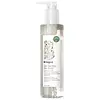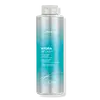What's inside
What's inside
 Key Ingredients
Key Ingredients

No key ingredients
 Benefits
Benefits

 Concerns
Concerns

 Ingredients Side-by-side
Ingredients Side-by-side

Water
Skin ConditioningSodium Lauroyl Methyl Isethionate
CleansingCocamidopropyl Betaine
CleansingGlycerin
HumectantAloe Barbadensis Leaf Juice
Skin ConditioningAvena Sativa Bran Extract
AbrasiveCamellia Sinensis Leaf Extract
AntimicrobialLimnanthes Alba Seed Oil
Skin ConditioningPanthenol
Skin ConditioningSodium Gluconate
Skin ConditioningCitric Acid
BufferingLeuconostoc/Radish Root Ferment Filtrate
AntimicrobialPanthenyl Hydroxypropyl Steardimonium Chloride
Tocopheryl Acetate
AntioxidantPotassium Sorbate
PreservativeSodium Benzoate
MaskingCaprylhydroxamic Acid
Benzyl Alcohol
PerfumingWater, Sodium Lauroyl Methyl Isethionate, Cocamidopropyl Betaine, Glycerin, Aloe Barbadensis Leaf Juice, Avena Sativa Bran Extract, Camellia Sinensis Leaf Extract, Limnanthes Alba Seed Oil, Panthenol, Sodium Gluconate, Citric Acid, Leuconostoc/Radish Root Ferment Filtrate, Panthenyl Hydroxypropyl Steardimonium Chloride, Tocopheryl Acetate, Potassium Sorbate, Sodium Benzoate, Caprylhydroxamic Acid, Benzyl Alcohol
Water
Skin ConditioningSodium Laureth Sulfate
CleansingCocamide Mipa
EmulsifyingDisodium Cocoamphodiacetate
CleansingGlycol Stearate
EmollientSodium Chloride
MaskingButyrospermum Parkii Butter
Skin ConditioningLaurdimonium Hydroxypropyl Hydrolyzed Keratin
Skin ConditioningArginine Hcl
Skin ConditioningPhosphatidylcholine
EmulsifyingRosa Canina Fruit Oil
EmollientCocos Nucifera Oil
MaskingHydrolyzed Algin
Sea Water
HumectantChlorella Vulgaris Extract
Skin ConditioningSodium Cetearyl Sulfate
CleansingCocamidopropyl Betaine
CleansingGuar Hydroxypropyltrimonium Chloride
Skin ConditioningCetyl Alcohol
EmollientAcrylates/Aminoacrylates/C10-30 Alkyl PEG-20 Itaconate Copolymer
Emulsion StabilisingDimethicone
EmollientSodium Citrate
BufferingCitric Acid
BufferingPEG-4 Laurate
EmulsifyingDisodium EDTA
Polyquaternium-7
DMDM Hydantoin
PreservativeIodopropynyl Butylcarbamate
PreservativeSodium Benzoate
MaskingMethylchloroisothiazolinone
PreservativeMethylisothiazolinone
PreservativePhenoxyethanol
PreservativePotassium Sorbate
PreservativeLinalool
PerfumingLimonene
PerfumingParfum
MaskingCI 42090
Cosmetic ColorantCI 60730
Cosmetic ColorantCI 19140
Cosmetic ColorantWater, Sodium Laureth Sulfate, Cocamide Mipa, Disodium Cocoamphodiacetate, Glycol Stearate, Sodium Chloride, Butyrospermum Parkii Butter, Laurdimonium Hydroxypropyl Hydrolyzed Keratin, Arginine Hcl, Phosphatidylcholine, Rosa Canina Fruit Oil, Cocos Nucifera Oil, Hydrolyzed Algin, Sea Water, Chlorella Vulgaris Extract, Sodium Cetearyl Sulfate, Cocamidopropyl Betaine, Guar Hydroxypropyltrimonium Chloride, Cetyl Alcohol, Acrylates/Aminoacrylates/C10-30 Alkyl PEG-20 Itaconate Copolymer, Dimethicone, Sodium Citrate, Citric Acid, PEG-4 Laurate, Disodium EDTA, Polyquaternium-7, DMDM Hydantoin, Iodopropynyl Butylcarbamate, Sodium Benzoate, Methylchloroisothiazolinone, Methylisothiazolinone, Phenoxyethanol, Potassium Sorbate, Linalool, Limonene, Parfum, CI 42090, CI 60730, CI 19140
Ingredients Explained
These ingredients are found in both products.
Ingredients higher up in an ingredient list are typically present in a larger amount.
Citric Acid is an alpha hydroxy acid (AHA) naturally found in citrus fruits like oranges, lemons, and limes.
Like other AHAs, citric acid can exfoliate skin by breaking down the bonds that hold dead skin cells together. This helps reveal smoother and brighter skin underneath.
However, this exfoliating effect only happens at high concentrations (20%) which can be hard to find in cosmetic products.
Due to this, citric acid is usually included in small amounts as a pH adjuster. This helps keep products slightly more acidic and compatible with skin's natural pH.
In skincare formulas, citric acid can:
While it can provide some skin benefits, research shows lactic acid and glycolic acid are generally more effective and less irritating exfoliants.
Most citric acid used in skincare today is made by fermenting sugars (usually from molasses). This synthetic version is identical to the natural citrus form but easier to stabilize and use in formulations.
Read more about some other popular AHA's here:
Learn more about Citric AcidCocamidopropyl Betaine is a fatty acid created by mixing similar compounds in coconut oil and dimethylaminopropylamine, a compound with two amino groups.
This ingredient is a surfactant and cleanser. It helps gather the dirt, pollutants, and other impurities in your skin to be washed away. It also helps thicken a product and make the texture more creamy.
Being created from coconut oil means Cocamidopropyl Betaine is hydrating for the skin.
While Cocamidopropyl Betaine was believed to be an allergen, a study from 2012 disproved this. It found two compounds in unpure Cocamidopropyl Betaine to be the irritants: aminoamide and 3-dimethylaminopropylamine. High-grade and pure Cocamidopropyl Betaine did not induce allergic reactions during this study.
Learn more about Cocamidopropyl BetainePotassium Sorbate is a preservative used to prevent yeast and mold in products. It is commonly found in both cosmetic and food products.
This ingredient comes from potassium salt derived from sorbic acid. Sorbic acid is a natural antibiotic and effective against fungus.
Both potassium sorbate and sorbic acid can be found in baked goods, cheeses, dried meats, dried fruit, ice cream, pickles, wine, yogurt, and more.
You'll often find this ingredient used with other preservatives.
Learn more about Potassium SorbateSodium Benzoate is a preservative. It's used in both cosmetic and food products to inhibit the growth of mold and bacteria. It is typically produced synthetically.
Both the US FDA and EU Health Committee have approved the use of sodium benzoate. In the US, levels of 0.1% (of the total product) are allowed.
Sodium benzoate works as a preservative by inhibiting the growth of bacteria inside of cells. It prevents the cell from fermenting a type of sugar using an enzyme called phosphofructokinase.
It is the salt of benzoic acid. Foods containing sodium benzoate include soda, salad dressings, condiments, fruit juices, wines, and snack foods.
Studies for using ascorbic acid and sodium benzoate in cosmetics are lacking, especially in skincare routines with multiple steps.
We always recommend speaking with a professional, such as a dermatologist, if you have any concerns.
Learn more about Sodium BenzoateWater. It's the most common cosmetic ingredient of all. You'll usually see it at the top of ingredient lists, meaning that it makes up the largest part of the product.
So why is it so popular? Water most often acts as a solvent - this means that it helps dissolve other ingredients into the formulation.
You'll also recognize water as that liquid we all need to stay alive. If you see this, drink a glass of water. Stay hydrated!
Learn more about Water